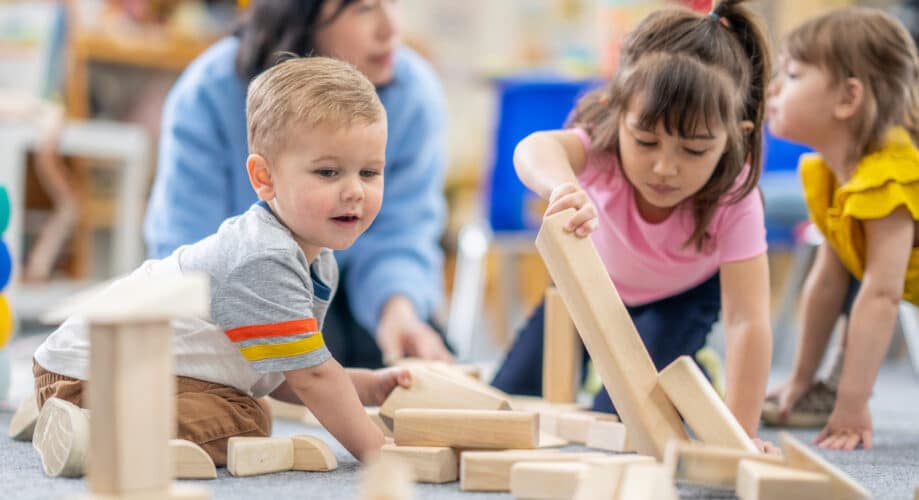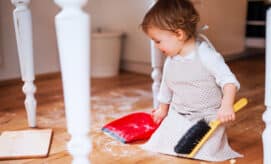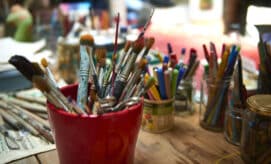In early learning classrooms and programs, children learn through exploration, inquiry, and playful experiences. When educators offer open-ended materials such as blocks and playdough that can be used in a variety of ways, they encourage children to follow their sense of curiosity, imagination, and creativity. In this article, we explore the power of open-ended materials to support exploration, learning, and development in early learning programs.
An Introduction to Open-ended Materials
The term open-ended materials refers to toys and other items that children can use in a variety of ways as they play. An article written by Carrie Shrier, a Michigan State University educator who specializes in child and family development, explains that “Open-ended play materials allow children to make choices, express their creativity, and support their independence. Open-ended materials, by definition, do not have a pre-determined use. A block can be a car, phone, doll’s chair, ice-cream bar, or any number of other things in play. It is through these experiences that children are able to learn best.”
Because open-ended materials don’t have a single purpose, they invite children to let their imagination and creativity guide the way they decide to use them. Open-ended play materials such as blocks, playdough, pinecones, and more are versatile and can be used in a new way each time they are used.
The Benefits of Open-ended Materials
Exploring and utilizing open-ended materials in early childhood classrooms has a variety of benefits for young children. Research shows that open-ended materials allow children to explore their interests, develop their sense of creativity, and practice self-expression. Through playful experiences with open-ended materials, children practice problem-solving, innovation, flexible thinking, reasoning, coordination, collaboration, and more. All of these skills help to prepare children for academic success as they approach kindergarten.
Examples of Open-ended Materials & How They Support Learning
- Playdough. Playdough is a great item to offer alongside other materials. It can inspire sensory exploration, be used to create food in a dramatic play kitchen, or be shaped into homes for play animals. Squeezing and squishing playdough is a fun way to strengthen developing muscles in hands and fingers. And, when children work with playdough alongside their peers, they are more likely to interact with one another and talk about what they are doing.
- Natural items. Pinecones, twigs, leaves, rocks, and seashells are examples of open-ended materials that build upon young children’s fascination with the natural world around them. These items from nature can be used in art, dramatic play, and STEM activities, and can inspire conversations with little ones about basic science concepts!
- Recycled items. There are so many examples of recycled materials that can be used in early learning classrooms for open-ended, playful learning! From egg cartons to cardboard boxes, from pieces of ribbon to fabric scraps, recycled materials are a great, low-cost item to add to your classroom play experiences. Giving items a second life helps to introduce children to concepts in conservation and sustainability, while also encouraging children to utilize their creativity and imagination to utilize these items in new ways.
- Blocks, legos, magna-tiles, and other building materials. Imagination and creativity can turn these building toys into almost anything. They can be incorporated into an art project, transformed into items as part of pretend play, used as a music-making percussion instrument, or become anything that enhances a child’s play experience. Blocks and other building materials also offer opportunities for children to practice using social and communication skills as they coordinate and collaborate with peers.
- Art materials. Art supplies such as paints, markers, crayons, stickers, and popsicle sticks are just a few of the art materials that children can use to enhance creative play. For example, children might use crayons and paper to create signs or props for a dramatic play center or a scenery backdrop for a puppet show. Markers can be writing tools for recordkeeping or journaling, as when the children decide to track and record the time it takes for each child to move through a hopscotch course, or take notes about the birds they observe in their outdoor play space. These materials can spark ideas for exploration and creative approaches to play and learning.
Tips for Introducing Open-Ended Materials into ECE Programs
1. Disperse Items Around the Room
Open-ended materials should be integrated throughout the classroom, rather than confined to a specific area. Make sure that children feel comfortable moving items from one learning center to another as they follow their creative instincts and ideas.
2. Provide Variety
Try to include a variety of textures, colors, and types of open-ended materials for children to incorporate into their play. For example, you might offer some empty cardboard boxes along with a bin of large scraps of fabric and a basket of seashells. Because these items are very different from one another, they will keep children interested and engaged as they interact with them in a variety of ways.
It is also important to avoid overwhelming children with too many different items at one time. Select a few, unique materials so that children can take as much time as they’d like to explore each of them. Once children seem to become less interested in particular items, you can rotate them out for something new.
3. Invite Children to Lead the Way
Open-ended materials encourage children to take the lead as they play and learn. Because these materials can be used in so many different ways, they invite children to follow their interests and experiment with possibilities. Taking ownership over their play engages children in the learning process and supports their developing sense of independence and confidence.
During open-ended play, educators can take a step back and adopt a supporting role by observing the children at play, asking questions, and offering words of encouragement.
Additional Resources
- NAEYC’s Message in a Backpack. Harnessing the Joy of Open-Ended Materials is a free, printable resource from NAEYC that’s designed for educators to share with families. The printable will help parents understand how the materials in your classroom support their child’s learning, and might even encourage them to offer open-ended materials during at-home play activities!
- Video from Edutopia – Using Open-Ended Materials to Spark Curiosity. This video highlights the benefits of open-ended materials and shows clips of educators introducing a variety of open-ended items to the children in their classrooms.
- Handout from Town Square. This two-page printable from Town Square, an ECE program from the Erikson Institute, highlights the power of open-ended materials to support early development and shares tips for introducing these materials to children in early learning classrooms.





